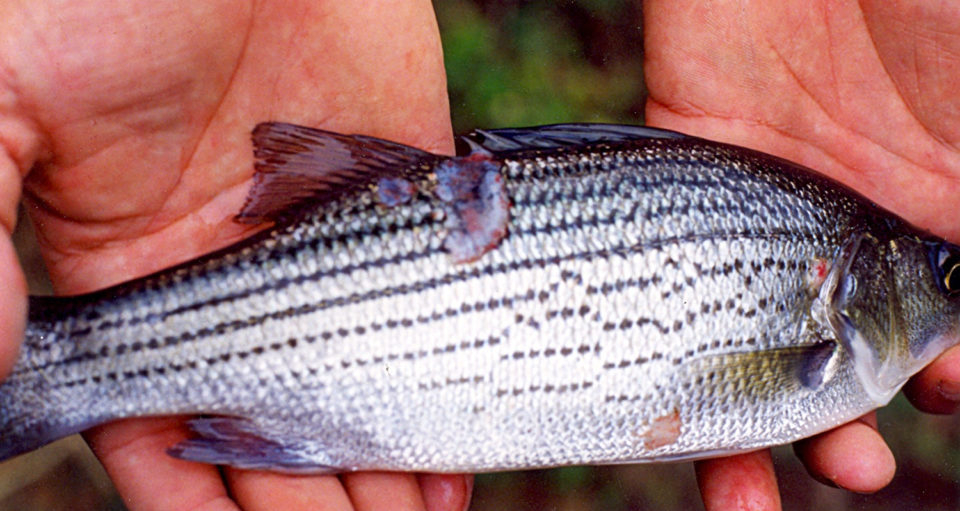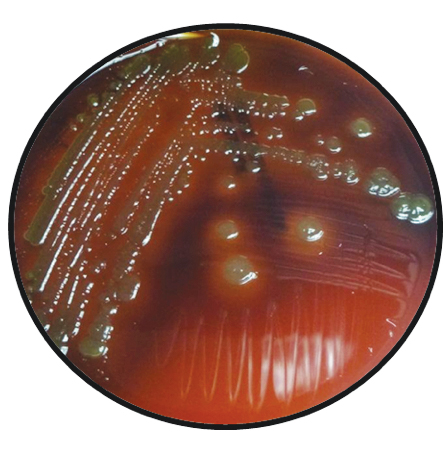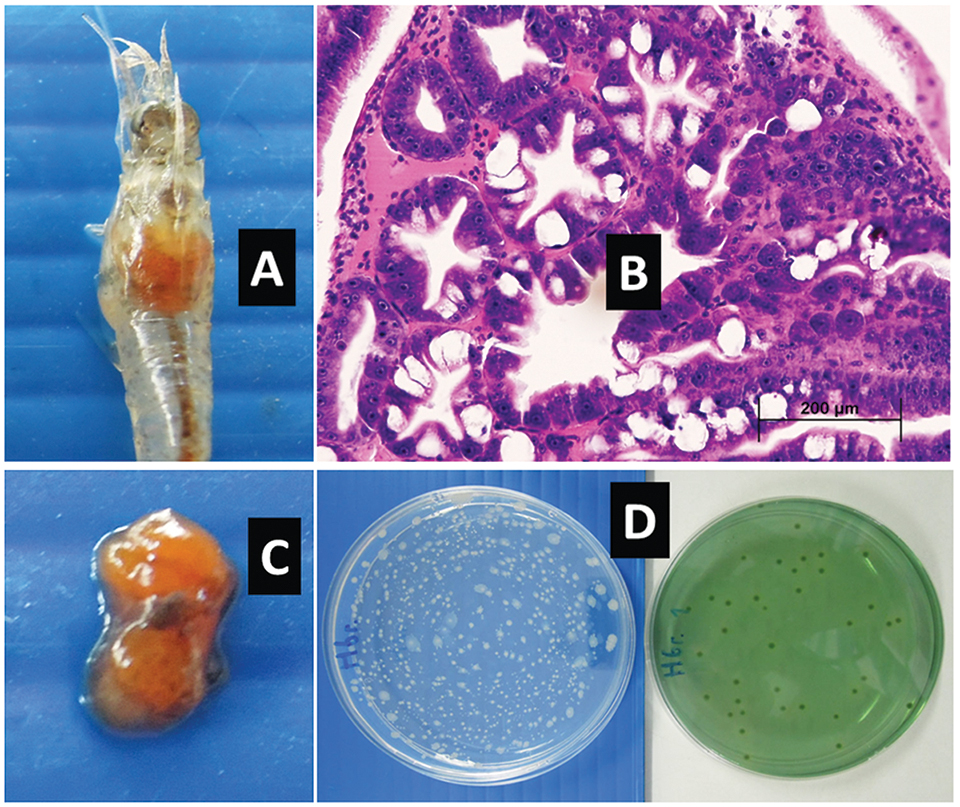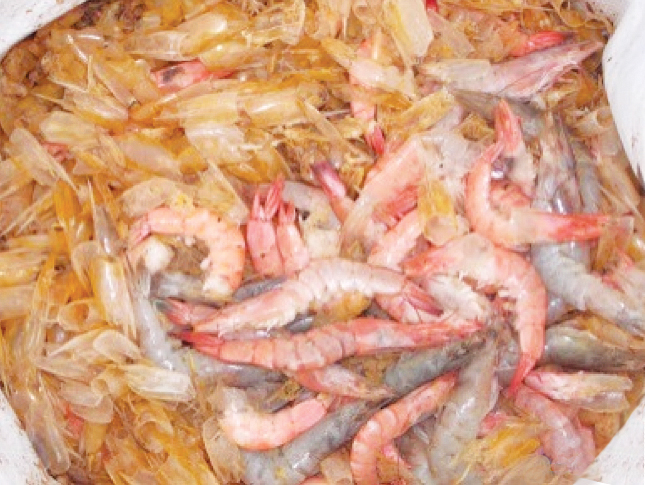Progress achieved in developing effective controls

Vibrio harveyi is a member of the genus Vibrio, in the family Vibrionaceae, order Vibrionales, class Gammaproteobacteria and phylum Proteobacteria. It occurs naturally in marine habitats and has developed into a significant pathogen of wild and cultured marine fish and invertebrates (notably penaeid shrimp), especially in warm waters of Asia, southern Europe and South America.
This article – adapted and summarized from the original publication [Zhang, X., He, X. & Austin, B. Vibrio harveyi: a serious pathogen of fish and invertebrates in mariculture. Mar Life Sci Technol (2020)] – discusses Vibrio harveyi and its role as a serious pathogen to several maricultured species. For detailed information on the taxonomy; diseases; diagnosis; pathogenic mechanisms and disease controls for V. harveyi, refer to the original publication.
The work was supported by the National Key Research and Development Program of China (No. 2018YFE0124100), the National Natural Science Foundation of China (Nos. 41730530 and 91751202), and Marine S&T Fund of Shandong Province for Pilot National Laboratory for Marine Science and Technology (Qingdao) (No. 2018SDKJ0406-4).
Diseases and diagnosis
V. harveyi has been linked with disease in several warmwater fish and invertebrates (Table 1). It has been often associated with eye disease, for example in common snook, milkfish and other fish species. Without effective chemotherapy, the infected fish would inevitably become blind.
In fish, the pathogen has also been attributed with gastroenteritis, necrotizing enteritis, nodules on the opercula, scale drop and muscle necrosis, skin ulcers, tail rot and vasculitis in different fish species. With the latter infection, the fish lacked appetite, were lethargic and disoriented, and displayed necrotic subdermal cysts. Internally, meningitis, encephalitis, vasculitis, kidney necrosis and liver and kidney damage were recorded. Also, V. harveyiappears to exert great severity on/in immunosuppressed fish.
Zhang, Vibrio harveyi, Table 1a
| Fish disease | Host | Range |
|---|
Fish disease | Host | Range |
|---|---|---|
| Eye disease | Common snook (Centropomus undecimalis); Milkfish (Chanos chanos); Short sunfish (Mola mola) | USA; Philippines; Spain |
| Gastroenteritis | Grouper (Epinephelus coioides); black sea bream, Japanese sea bass, yellowfin sea bream and red drum | Taiwan, China; Taiwan, China |
| Necrotizing enteritis | Summer flounder (Paralichthys dentatus) | USA |
| Nodules on operculum | Tiger puffer (Takifugu rubripes) | Japan |
| Scale drop and muscle necrosis | Barramundi (Lates calcarifer); Hybrid grouper (Epinephelus fuscoguttatus x E. lanceolatus) | Vietnam; China |
| Skin ulcers | Sole (Solea senegalensis); Hybrid grouper (E. fuscoguttatus x E. lanceolatus) | Spain; China |
| Tail rot disease | Sea perch (Lateolabrax japonicus); Sea bream (Sparus aurata) | China; Malta |
Zhang, Vibrio harveyi, Table 1b
| Invertebrate disease | Host | Range |
|---|
Invertebrate disease | Host | Range |
|---|---|---|
| Acute hepatopancreatic necrosis disease | Whiteleg shrimp (Litopenaeus vannemei) | Malaysia |
| Bacterial white tail disease | Whiteleg shrimp (Litopenaeus vannemei) | China |
| Black shell disease | Black tiger shrimp (Penaeus monodon) | India |
| Bolitas negricans | Penaeid shrimp | Ecuador |
| Foot pustule disease | Abalone (Haliotis discus hannai) | China |
| Luminous vibriosis | Penaeid shrimp | Ecuador, Asia |
| Skin ulceration | Sea cucumber (Holothuria scabra) | Madagascar |
| White spot on the foot | Japanese abalone (Sulculus diversicolor) | Japan |
V. harveyi has been particularly troublesome in shrimp culture. The pathogen has been recovered from outbreaks of Bolitas negricans (Spanish = small balls; diseased shrimps contain balled epidermal tissue which can block the digestive tract) in Ecuador and luminous vibriosis (diseased animals can glow in the dark), and linked with black shell disease in black tiger shrimp (Penaeus monodon) in India and bacterial white tail disease in Pacific white shrimp (Litopenaeus vannamei) in China. With the latter disease, mass mortalities have been reported in which the affected shrimp displayed white or opaque lesions in the tail, which were attributed to muscle necrosis.
Together with V. parahaemolyticus, V. owensii, V. campbellii and V. punensis, V. harveyi has been reported to cause acute hepatopancreatic necrosis disease (AHPND) in Pacific white shrimp (L. vannamei) in Malaysian shrimp ponds. And its pathogenicity was confirmed in infectivity experiments.
Regarding diagnostic methods, modern molecular approaches have discriminating accuracy and include 16S rRNA gene sequencing, which has become the favored method of identifying isolates accurately and multilocus sequence analysis. Several polymerase chain reaction (PCR) tests have been developed to detect and diagnose V. harveyi, including a multiplex PCR, an enterobacterial repetitive intergenic consensus (ERIC)-PCR, and a specific recombinase polymerase amplification (RPA) designed specifically to recognize the V. harveyi toxR gene. There are also serological [study of serum and other bodily fluids] approaches available, including chemiluminescent-based dot blot test [a technique in molecular biology used to detect proteins].
Pathogenic mechanisms
Much of the research on pathogenicity has involved the use of laboratory cultures, some of which are of uncertain authenticity/identity. Therefore, there may be questions concerning whether or not the research has actually used genuine V. harveyi cultures, and the actual relevance of the data to the host. An initial conclusion may be reached that the pathogenicity mechanisms remain to be properly resolved. Nevertheless, infections and mortalities have been achieved using fish and cultures.
There are several known pathogenicity mechanisms and virulence factors for V. harveyi, including hemolysins, proteases, lipopolysaccharide (LPS), the capacity to bind iron, interaction with bacteriophages, biofilm formation, and quorum sensing. It is possible that pathogenicity reflects the interaction between two or more virulence factors functioning together or sequentially. Moreover, it is important to realize that the pathogenicity mechanisms of V. harveyi to fish and invertebrates may well be different.
Disease control
Multiple studies have addressed the spread of disease associated with V. harveyi, and initially, the use of antimicrobial compounds like Prefuran and oxytetracycline were successful. However, the concern over tissue residues and the development and spread of antibiotic resistance contributed to research in other areas of disease control, notably preventative rather curative.
Bacteriophage therapy
Some research has focused on bacteriophage therapy [curative use of bacteriophages – virus that infect and replicate within bacteria – to treat pathogenic bacterial infections] to control luminous vibriosis in shrimp aquaculture. For example, a cocktail of three bacteriophages isolated from shrimp farms in India, inhibited V. harveyi and resulted in greater survival of tiger shrimp larvae compared to controls.
Biological control
One example is the successful use of certain surface-associated bacteria recovered from sea cucumbers to control V. harveyi disease in brown-marbled grouper fingerlings. And for Pacific white shrimp, research has suggested that culture in biofloc can reduce hepatopancreas lesions attributed to V. harveyi.
Dietary supplements
A wide range of dietary supplements have been proposed for the control of V. harveyi. Some have been commercialized, particularly in the Far East, for use with fish and shellfish. Other examples for use in fish include β-1,3-glucan, bovine lactoferrin, Chaga mushroom, the seed of the evergreen tree Leucaena leucocephala, garlic, ginger, green tea (Camellia sinensis), hawthorn (Crataegus sp.) extract, Japanese pepper tree (Zanthoxylum piperitum), kudzu (Pueraria thunbergiana), loquat tree (Eriobotrya japonica) and pericarp (Zanthoxylum piperitum). Immunomodulation and protection against challenge were common with the use of these dietary supplements.
Numerous dietary supplements have been researched for use with shrimp, including black nightshade (Solanum nigrum) extract and mangrove (Rhizophora apiculata) leaf extract. Probiotics have also been evaluated for control of V. harveyi infections, including Bacillus coagulans, marine red yeast (Rhodotorula mucilaginosa) and the marine bacterium Pseudoalteromonas flavipulchra JG1.
A common theme with the use of dietary supplements is evidence for improved growth performance, immunomodulation notably of cellular and innate immunit, and protection against challenge with V. harveyi. This raises the question concerning the reason(s) for the profound benefit of what is essentially the addition of a small quantity of dietary supplement. Could the reason reflect inadequacies in the formulation of diets or are these truly supplements, i.e., supplementing already adequate feed?
Inhibition of quorum sensing
Quorum-sensing signal molecules may be involved in regulating virulence. For example, a protein of Bacillus thuringiensis interfered with quorum sensing in V. harveyi and could be considered for disease control strategies.
Vaccines
Although vaccines are primarily used to control diseases of fish, some commercial products containing V. harveyi antigens have been marketed for the control of shrimp diseases in the Far East. But most of the research has been directed at the control of fish disease. There has been a dramatic improvement in the success of vaccines for the control of V. harveyidiseases, with research efforts that started with the traditional approach of inactivated whole-cell preparations progressing to purified subcellular components, and subsequently to the modern era of DNA vaccines.
Various types of vaccines have been developed for the control of V. harveyi diseases, including whole-cell vaccines, subunit vaccines, live vaccines and DNA vaccines. Although significant published research has been encouraging in terms of success of vaccines after challenge, it remains to be determined which vaccines could be produced at the price that the users would be prepared to pay.
Perspectives
Vibrio harveyi is a serious pathogen for multiple species of marine fish and invertebrates particularly in the warm waters of Asia, southern Europe and South America. Although its virulence has been demonstrated with multiple isolates, there is a lack of clarity over the precise pathogenicity mechanisms, possibly reflecting differences between isolates as well as between fish and invertebrates, and overreliance on laboratory cultures, which are not necessarily reflective of the abilities of fresh isolates.
There has been much progress with the development of effective disease control strategies, including use of dietary supplements and vaccines. Clearly, further work is justified to better understand this serious pathogen of marine animals.
References available from the original publication.
Now that you've reached the end of the article ...
… please consider supporting GSA’s mission to advance responsible seafood practices through education, advocacy and third-party assurances. The Advocate aims to document the evolution of responsible seafood practices and share the expansive knowledge of our vast network of contributors.
By becoming a Global Seafood Alliance member, you’re ensuring that all of the pre-competitive work we do through member benefits, resources and events can continue. Individual membership costs just $50 a year.
Not a GSA member? Join us.
Authors
-
Dr. Xiao-Hua Zhang
Corresponding author
MOE Key Laboratory of Marine Genetics and Breeding
College of Marine Life Sciences
Ocean University of China
Qingdao, 266003, China; and
Laboratory for Marine Ecology and Environmental Science
Qingdao National Laboratory for Marine Science and Technology
Qingdao, 266237, China; and
Frontiers Science Center for Deep Ocean Multispheres and Earth System
Ocean University of China
Qingdao, 266100, China -
Dr. Xinxin He
MOE Key Laboratory of Marine Genetics and Breeding
College of Marine Life Sciences
Ocean University of China
Qingdao, 266003, China -
Dr. Brian Austin
Institute of Aquaculture
University of Stirling
Stirling, FK9 4LA, Scotland, UK
Related Posts

Health & Welfare
A holistic management approach to EMS
Early Mortality Syndrome has devastated farmed shrimp in Asia and Latin America. With better understanding of the pathogen and the development and improvement of novel strategies, shrimp farmers are now able to better manage the disease.

Health & Welfare
Field diagnostic tools for pathogenic vibrios
Since Vibrio samples often degrade during transport, the authors analyzed nucleic acids (FTA) cards as a simplified, shelf-stable collection method for the preservation of genetic material from water samples.

Health & Welfare
Hepatopancreas colors predict survival of shrimp to EMS
Monitoring of Vibrio bacteria in shrimp larvae determined a relationship among hepatopancreas color, bacteria concentration and signs of early mortality syndrome.

Health & Welfare
Stress-vibrio dynamics during high-density, zero-exchange production of white shrimp
Vibrio infections are an increasingly common problem in intensive shrimp culture. As evidenced by study results, weekly Vibrio monitoring can be a useful tool for predicting bacterial disease outbreaks.


